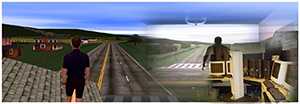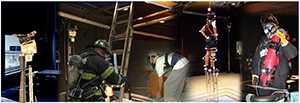FALLS IN THE WORKPLACE
NIOSH Labs
NIOSH’s Division of Safety Research (DSR) uses different labs to conduct research that identifies, reduces, and prevents work-related injuries and deaths across all industries. Review our Traumatic Occupational Injury Research Labs brochure for an overview of DSR labs, and continue reading for more detailed information about three of our labs.
Virtual Reality Laboratory

The NIOSH Virtual Reality Laboratory contains a simulation space with a computer-generated projection that gives users the illusion of being immersed in a three-dimensional world. How does it work? The user wears special eyewear that synchronizes and filters the projected images to create a realistic impression of a three-dimensional space. A motion tracking system continuously adjusts the projection to the current position of the user, tracking the subject’s position and updating the projection in real time. This lab is also equipped with a six-camera VICON motion measurement system to capture movements of human subjects in the virtual environment. Users’ physiological responses can also be captured using a Biolog Data Recorder.
NIOSH scientists have developed virtual environments that simulate dangerous working conditions to evaluate innovative fall prevention strategies without placing human subjects at real risk. An example of a dangerous working condition is construction work at heights. Subjects can be studied working at virtual heights in a safely controlled laboratory. This lab is also being used to visualize scientific concepts or virtual prototypes, such as vehicle cab controls, brain neural cells, and protective gear, for further discussion and enhancement.
This 28- by 35- by 14-foot laboratory is currently being utilized to better understand human behavior, physical responses, and decision-making skills under simulated conditions of elevated work, such as scaffolding, roofing, and ladder use tasks. The Virtual Reality Laboratory was developed in 1996 and updated to a digital format in 2010. The NIOSH fully immersive Virtual Reality Laboratory is among the largest in scale of its kind and is one of very few being utilized for occupational safety research applications in the country.
Human Factors Laboratory

The NIOSH Human Factors Laboratory is a unique facility for research in the areas of biomechanics, applied physiology, and industrial psychology. The 30- by 40-foot lab has a 17-foot-high ceiling to permit the study of a variety of simulated work practices.
This laboratory is equipped with four core systems:
- an environmental control unit (ECU)
- a six-camera VICON motion measurement system
- two in-floor force platforms
- a frictionless fall-arrest system.
An electromyography (EMG) measurement system and physical signal measurement devices are synchronized with the core systems. The ECU can control temperature, humidity, and lighting with a high degree of precision. Temperature can be controlled in a range of 35o F to 95o F. Humidity can be adjusted from 30% to 90%. Lighting can be attuned from 0.1 to 100 foot candles to simulate various industrial work conditions. The frictionless fall-arrest system is a fall protection system with a motion sensing mechanism which allows human subjects to perform their task naturally while wearing a fall-arrest harness and being connected to an overhead protective railing structure. The motion sensing mechanism will activate a fall arrest should a subject slip or trip during a study.
The laboratory was completed in 1995 and remains among only a few research facilities worldwide with the capacity for conducting research on the interactive effects of biomechanics, physiological loads, and psychological stress on workers. It has been used to support studies of:
- postural stability
- human motor and mental responses
- machine safety
- acute musculoskeletal injuries
- heat stress evaluations.
These studies have included research on the human factors associated with the use of:
- various types of fire fighters boots
- slip and fall prevention in healthcare settings
- worker fall risk control while performing tasks on the platform of an aerial lift
- joint biomechanical loadings of construction workers who use stilts
- the forces imposed on the human body during the lifting and movement of drywall sheets.
High Bay Laboratory

Containing a 37-foot-high ceiling with an overhead catwalk, the NIOSH High Bay Laboratory is dedicated to research efforts in reducing fall-related injuries and improving the safety of large equipment used in industrial, construction, and agricultural applications. Test equipment includes a 5-ton bridge crane, a test bed, an MTS hydraulic power supply and actuator system, and a research manikin.
The laboratory, which was developed in 1995, has been used for projects related to improving:
- scaffolding stability
- ladder safety
- design of tractor rollover protective structures
- tension/compression testing of fabricated protective structures
- ingress/egress safety for construction equipment.
Facts about our test equipment:
- The hydraulic actuators can produce up to 20,000 pounds of force.
- The Advanced Dynamic Anthropomorphic Manikin (ADAM) is representative of a 95th percentile Air Force male. ADAM contains a sophisticated and ruggedized onboard data acquisition system, joint sensors, three tri-axial accelerometers (located in the head, chest, and lower torso), and two load cells (located at the neck and lower spine). ADAM has been used in a series of tests on the biodynamic forces that protective equipment and the human body would experience during free-fall and rapid deceleration while wearing fall-restraint equipment.
- Equipped with protective rails, a catwalk provides a mechanism for studying human perception and responses at heights.
- Page last reviewed: April 12, 2017
- Page last updated: October 25, 2016
- Content source:
- National Institute for Occupational Safety and Health Division of Safety Research


 ShareCompartir
ShareCompartir